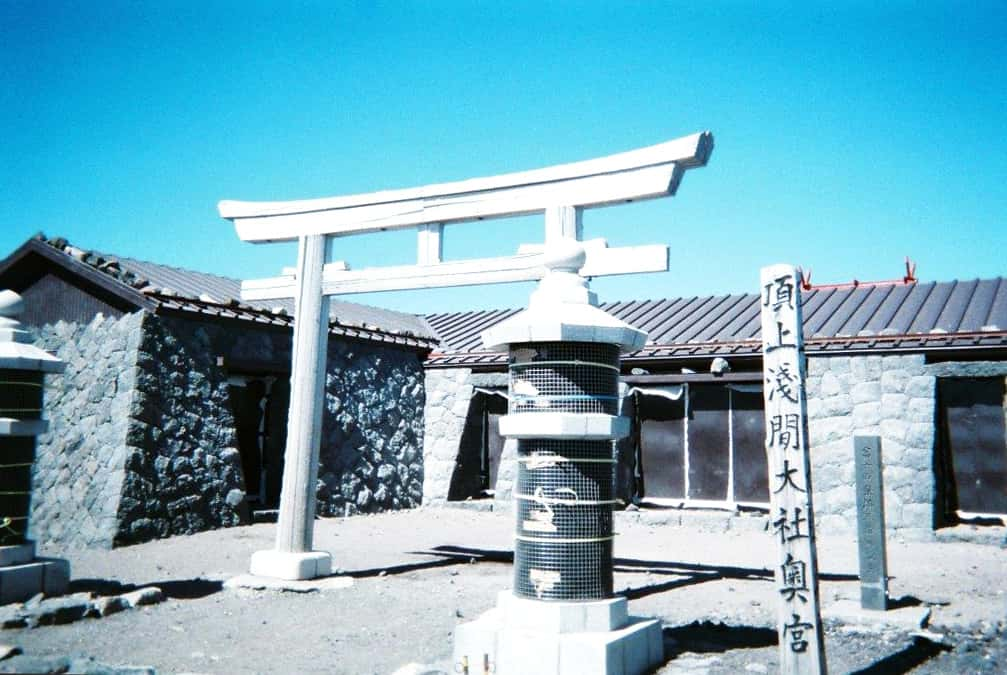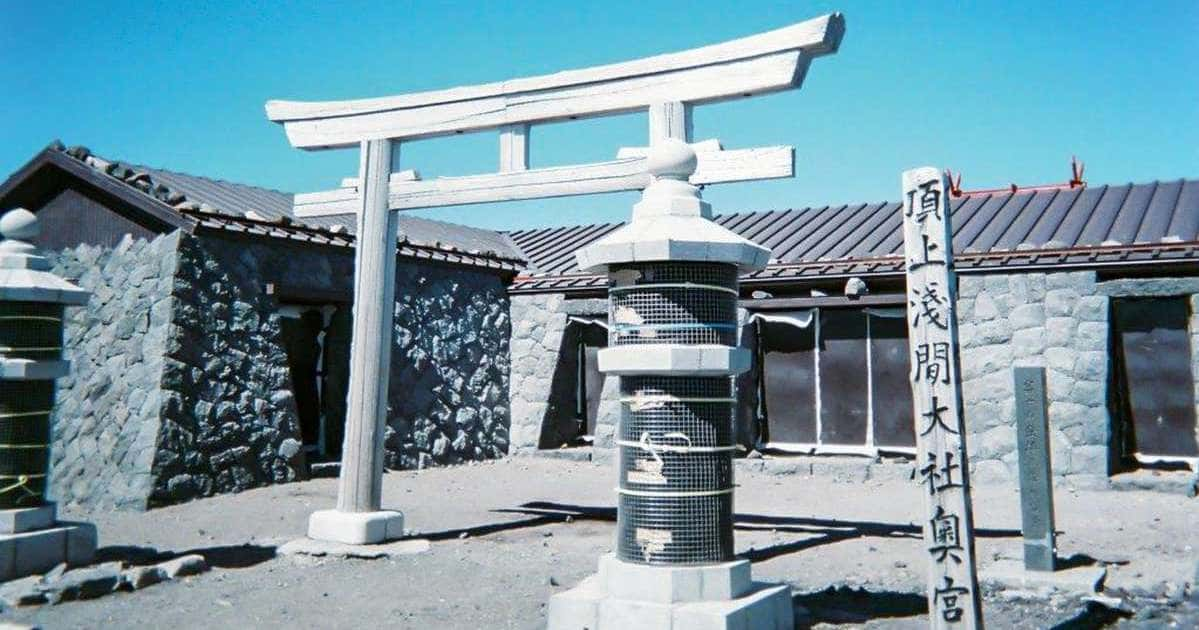
目次
- Target date for climbing to the top of Mt. Fuji: September 23rd!
- Four different climbing routes on Mt. Fuji
- I chose the Fujinomiya route!
- Fuji, I am fully prepared for the summit!
- Astonished at the pitfalls of mountaineering preparation!
- The spectacular view from the trail encouraged me!
- The pained expressions on the faces of climbers descending the mountain?
- First time experiencing symptoms of altitude sickness!
- Still Determined to Reach the Summit of Mt. Fuji!
- Conquering the summit of Mt. Fuji, where joy and pain coexist.
- Mt. Fuji summit in calm conditions!
- Happenings are bound to occur at the summit of Mt. Fuji
- The fear of altitude sickness makes you lose track of time!
- Descending the terrifying zigzagging roadway from the summit of Mt. Fuji!
- The crisis of losing a flashlight at night on Mt!
- Surviving the darkness with only a safety tether
- Thanks to an inspiring day of safe ascent to the summit!
Target date for climbing to the top of Mt. Fuji: September 23rd!
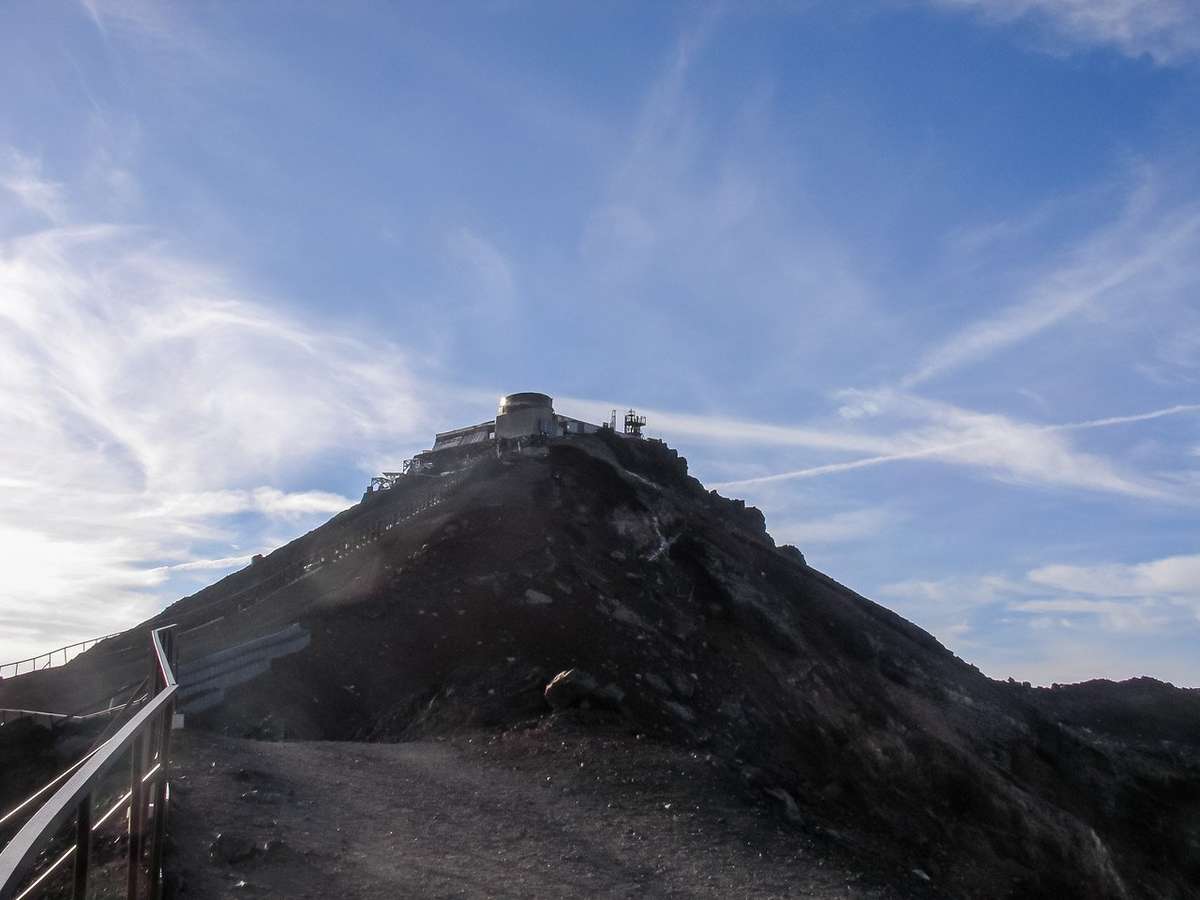
Mt. Fuji’s Summit KengamineOn September 23, 2014 on the day of the autumnal equinox, a turbulent day began. The day had finally arrived for me to take the challenge to climb the summit of Mt. Fuji, a mountain I had long wanted to climb at least once while I was healthy and had the leg strength to do so. I had climbed mountains in the 2000-meter class dozens of times before and was confident in my physical strength, so I thought I could conquer the summit of Mt. Fuji during a day trip. If I were to go through the trouble of climbing the mountain, I wanted to enjoy the panoramic view from the top of Mt. Fuji. So, in order to avoid the heavy crowds, I eagerly waited for a day of good weather in the off-season before the first snowfall.
That year I was already 56 and I felt that I was not getting any younger. Also, Mt. Fuji could erupt anytime soon. I knew that if I missed this year, I would not have another chance to climb Mt. Fuji. So, as soon as September arrived, I started reading information on climbing Mt. Fuji. The information I found via the Internet was very important to me as today’s weather forecasts are quite accurate and can be checked up to 10 days in advance at any time. The weather forecast data then helped mes to narrow down my target date for climbing in late September, when the climbing season is over and there are less crowds.
However, Typhoon No. 16 was causing trouble off the coast of the Philippines on September 18th and caused major damage in the Philippines on September 20th, Taiwan on September 21st, and even hit Ningbo, China on September 22nd. The typhoon was predicted to hit Japan at any time, and the weather was going to get quite rough after September 24th. In other words, after the 24th, the winds at the top of Mt. Fuji were predicted to become stronger and snow was a very real possibility, so I knew I had no choice but to leave before then. I had to leave before the typhoon arrived, and as I was poring over the weather forecast day after day trying to find a day when the weather would be mostly clear, I found that there was one clear day. It was the autumnal equinox holiday on September 23rd. As I watched the weather forecast, I was convinced that the autumnal equinox day would be my last chance, as the typhoon clouds were moving northward from the Philippines to China, and then changing course towards Kyushu.
Four different climbing routes on Mt. Fuji
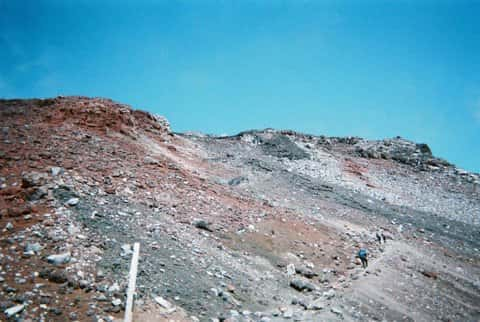
The way to the summit of Mt. Fuji.I had no way of knowing what routes were available to the summit until I decided to climb Mt. Fuji. With only a month before the climb, I searched via the Internet and found that there were four main routes to the summit. Mt. Fuji is designated as a World Heritage site, so the trails are well maintained. Mt. Fuji has rest areas, restrooms, and mountain huts located throughout the trails where many people climb. Depending on their experience and level of difficulty they’re looking for, climbers can choose from four different climbing routes to reach the summit.
The main route to Mt. Fuji is the Gotemba route. The ancient peoples who discovered this sacred mountain must have walked from Gotemba in the south, most likely along the gently sloping foot of Mt. Fuji, and continued their ascent to the summit. However, since the elevation of the trailhead is 1,000 meters lower than other routes, the walking distance is not only much longer, but there is no first-aid station, so we really had to be prepared for the challenge. This route was great to climb for experiencing the blessings of nature and immersing ourselves in discovering how the ancient people who climbed this route before us must have felt as they were climbing this path.
The other three routes are shorter than the Gotemba Route and each has a different feature about it. The Yoshida Route is the most popular route. Climbers drive from the Yamanashi side via the Fuji-Subaru Line to reach the fifth station and begin climbing. The second most popular route is the Fujinomiya Route, which is also accessible by car via the Fujiyama Skyline on the south side of the Mt. Fuji skyline. This route is south of Mt. Fuji and many people start climbing from there. Like the Yoshida route, there are mountain lodges and rest areas, but since the ascent and descent routes are exactly the same, it can be difficult to get back and forth when the routes become crowded. Last is the Subashiri route. This route has long attracted mountaineering enthusiasts because there are few climbers who can enjoy nature to the fullest. The downside is that there is no first-aid station and people are forewarned that this route is only recommended for those with a certain amount of mountaineering experience.
I chose the Fujinomiya route!

Mount Fuji trailI chose the Fujinomiya Route as the best route for off-season climbing in September. Even in late September when all rest areas are closed, it is possible to reach the fifth station by car via the Mt. Fuji route. Moreover, not only is the starting point at a high elevation, but the distance to the summit is also short, as the climb is almost a straight line. Given my confidence in my leg strength, it definitely seemed like the best route.
The Fujinomiya route is about 1,300 meters to the summit, which is only 60% longer than the 800-meter difference in elevation from Shikoku’s Ishizuchi Mountain, a mountain that I have climbed many times. In fact, I had already made two round trips in one day from the Jyojyusya shrine at the foot of Mt. Ichizushi. All that I really needed was a perfect climbing day.
Fuji, I am fully prepared for the summit!
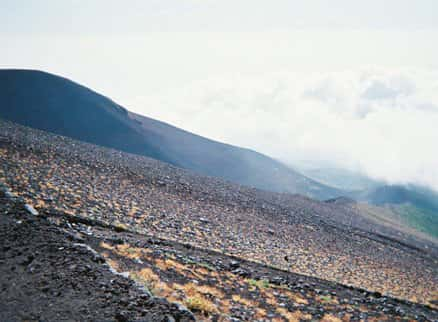
The scenery at the foot of Mt. FujiI immediately began preparing for my climbing day on September 23rd. I had to carefully plan for Mt Fuji’s 3,776-meters-tall, which is an altitude that I had never climbed before and I had to carefully plan for this. First, the walking distance was overwhelmingly long, and I assumed that it would require twice the physical strength of Shikoku’s Mt. Ishizuchi, so I prepared for the climb like we would for a marathon. According to the “Estimated Ascent/Descent Route Time” published by the Ministry of the Environment, the estimated time is 4 hours and 20 minutes to climb the mountain from Fujinomiya Gogo Entrance and 2 hours and 5 minutes to descend, for a total of 6 hours and 25 minutes. In addition, the weather conditions could have changed suddenly during the climb, and there was a risk of altitude sickness. Therefore, I had to prepare for all the worst possible scenarios.
I first took the time to learn a little about altitude sickness since I would be climbing to an altitude of 3776 m, an altitude I had never ascended to before. I had climbed mountains in the 2000-meter class many times before, but all I needed were light running clothes and light equipment, so I had to study about how I was going to prepare for this type of climb. As for clothing, the group and I decided to wear warm winter tops and bottoms from the starting point of the climb.
As for the items that I was going to carry, I prepared more water and food than I ever had before due to the long walking distance and the amount of time I would spend walking. I decided to carry three 500 ml plastic bottles of water and Calorie Mate as emergency food in addition to onigiri rice balls and nutritional drinks. And, I also prepared a flashlight in case of an emergency. I happened to have a hand-cranked flashlight on hand. Although it was a very primitive type, I decided to bring it along anyway because I thought it would serve me well. I had no way of knowing if I would actually have to use the flashlight or not.
Preparing for a climb is more than just preparing a list of equipment. The most important thing is taking care of your health first and foremost. So, I started running and weight training on a daily basis to build up my overall muscle strength and to keep myself in good physical condition several weeks before my target climb date. Since I had reached my peak physical condition, all I could do was hope for great weather.
Astonished at the pitfalls of mountaineering preparation!
I woke up early in the morning at 5:00 a.m. on September 23, the day of the vernal equinox, in my home in Tokyo. I had assumed from the beginning that we would start climbing Mt. Fuji by 8:00 a.m., so even if I woke up at 5:00 a.m., I would still make it in time. Although the start time was a little late, my strategy was to prioritize getting enough sleep and staying in good shape rather than waking up with the sunrise. From the morning, the weather in the Kanto area was sunny with high warm temperatures. The forecast also confirmed that temperatures around Fujiyoshida would rise to around 22 to 23 degrees celsius, so it was going to be the perfect day for climbing.
Driving on the Tomei Expressway went smoothly in the early morning. I left home by car and got off at the Gotemba Interchange heading towards Mt. Fuji. Since this was the off-season, I assumed there would be no restrooms, so I decided to stop at a convenience store to make sure I bought any more supplies that I needed and made sure to use the restrooms. Suddenly, when we stepped out of the car, I realized I had a big problem.
To my surprise, I had forgotten both of my cell phones that I always keep on me at home. I was absolutely mortified by this blunder! Cell phones are an absolute necessity when climbing Mt. Fuji because it sends me all the information that I need for climbing. Climbing the mountain alone without one is a huge risk in the event of an accident or injury. Despite my careful preparation, I can’t believe that I still forgot a very important piece of equipment.
Moreover, I had planned to take pictures using the camera function of my phone, so I didn’t have a camera either. Stunned by my own stupidity, I could not think of turning back after having come so far, so I had no choice but to buy an old-fashioned disposable camera at a convenience store. 39 shots were enough for me to buy one, but I later regretted this decision.
My once-in-a-lifetime climb to the summit of Mt. Fuji could not be ruined at any cost. At any rate, I was relieved that I was at least able to purchase a camera. Even without a cell phone, I only had to make sure I didn’t get lost, so I told myself, “I’ll be fine.” and drove the car again toward Mt. Fuji.
The spectacular view from the trail encouraged me!
I arrived at the Fujinomiya Fifth Station Rest House area at 7:30 in the morning. Being the off-season, the area was sparsely populated, and only a few dozen cars were parked along the road facing the trail. Fortunately, a parking space for one car was available along the mountain, so we parked my car there and made a final check before heading for the summit. I thought the temperature would be quite cold since I was at the fifth station, but it wasn’t chilly when I got out of the car and the air felt like it was about 16 to 17 degrees Celsius. There was not a lot of wind and the weather was fine. I thought this would allow me to climb lightly, so I decided to wear only a sweatshirt over a long-sleeved shirt as a jacket.
The parking lot was about 100 meters from the entrance to the trail, but on the mountainside I could see the remains of a large zigzagging road along the trail. I happened to meet two women coming down from there and asked, “Can we climb up from here?” They said, “Yes, you can.” I took advantage of the opportunity and began to climb along the trail from the path. The path soon joined the trail, and my assumption that Mt. Fuji had a variety of trails that we could walk on turned out to be a huge disaster. While I was descending the mountain, I mistook the zigzag path meant for cars as a trail.
From the fifth to the sixth stations on the Fujinomiya route, I continued on a gentle trail with a rough, sandy feel mixed with rocks and hiked up the trail at a brisk pace. I felt so thankful for the beautiful weather, and after a little more than 10 minutes, I soon arrived at the sixth station hut. Inside the hut, two men were talking and there was a line of toilets out front. I tried to open the door, but it was locked and I couldn’t open it. Upon closer inspection, I found that the door was coin-operated with a 200-yen fee, and coins had to be inserted in to open it. I had some cash on me, but I only had one 10,000 yen bill on me. I felt bad asking for change, so I told myself I could hold out for a day and left the lodge. Mt. Fuji is a sacred mountain, so I wanted to avoid going on the side of the road as much as possible.
Once back on the trail and beginning the ascent, the path from the sixth station changed and a steep rocky slope followed. The volcanic ash rocks are slippery, so I had to watch our footing. Looking up to the right side of the trail, I could see a rocky area with huge, slender boulders taller than I am stretching over dozens of meters. In the vast wilderness of Mt. Fuji, even the huge boulders seemed small. It was fun to casually walk past them.
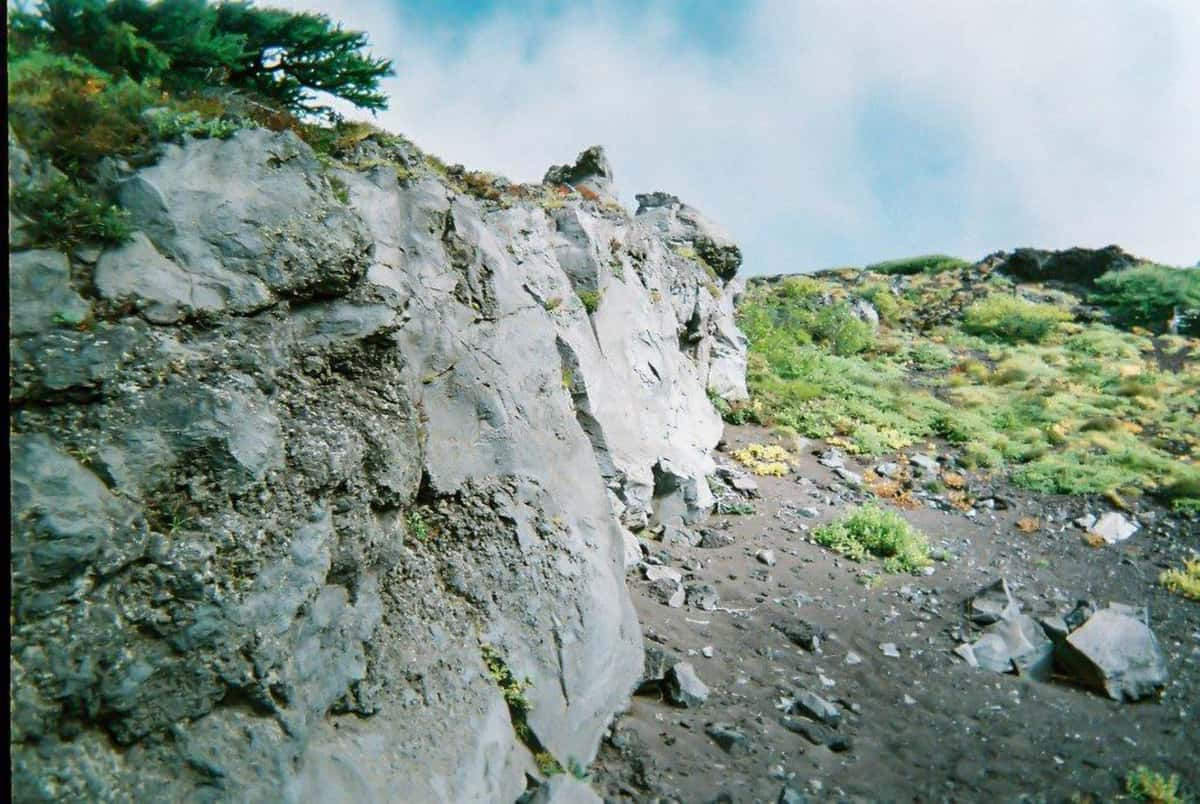
Boulders lined up just after the 6th Station of Mt. Fuji
Nevertheless, it was quite a beautiful day. As soon as I looked up, I noticed that the sky was such a clear blue. The wind was hardly blowing at all, and the temperature rose higher and higher as time went by. Even the sweatshirt I had prepared for the hike was no longer able to stop me from sweating as I huffed and puffed up the trail, so I quickly took it off and went down to a thin, long-sleeved shirt. Still, it was surprising that I was blessed with sunshine warm enough to make us sweat. The fine weather not only allowed me to enjoy the magnificent view of the beautiful sea of clouds, but I could also see the Pacific coast in the distance through the clouds. I was also able to see thick clouds in the west due to the low-pressure clouds over western Japan and the typhoon that followed, and I was filled with emotion that indeed this is Mt.Fuji.
The pained expressions on the faces of climbers descending the mountain?
When climbing a mountain, it is polite to say “Hello!” to other climbers as you pass by them. However, in the off-season, you may only see a few people in the distance. Mt. Fuji in the off-season is a great place to enjoy some mountain time alone, and just being out in nature will really put your mind in a better place.
As I continue to climb and pass the original seventh station hut at an altitude of over 3,000 meters on the side, I can see that the craggy rocks that I had seen before are gradually changing to a mountain path made of sand-like pieces of volcanic ash. The impression is that the volcanic ash sand is becoming more and more sandy in between the rocky areas. Every time you step out, the sound of your footsteps, jari, jari, makes you feel that you are strangely climbing a mountain in the midst of Mother Nature. However, it is also true that the footing is loose, and it is easy to slip and expend energy, so care was needed. For this reason, ropes are placed along the trails of Mt. Fuji, so that anyone can not only climb the prescribed mountain path without getting lost, but also quickly grab hold of them if they feel like they are about to fall.
After walking for a while, I saw a couple and an elementary school-aged girl coming down the mountain and asked, “How was the view at the top?” Surprisingly, her answer was, “My daughter said her head hurts, so we gave up just before the summit and came back. The family was almost at the summit when the little girl developed symptoms of altitude sickness, so the parents decided to be more cautious and go back down the mountain even though they just almost reached the top. Climbing Mt. Fuji takes a different kind of courage to endure it.
First time experiencing symptoms of altitude sickness!
I didn’t have a cell phone and I don’t usually wear a watch, so I was climbing the mountain without knowing what time it was. However, since it was the autumnal equinox, we could guess the approximate time from the position of the sun and the angle of sunlight. This is what the ancient people here did so long ago. About an hour and a half after our departure, I arrived at the eighth station lodge. From the eighth station, I knew that I had finally entered the sacred area of the Okumiya Shrine.
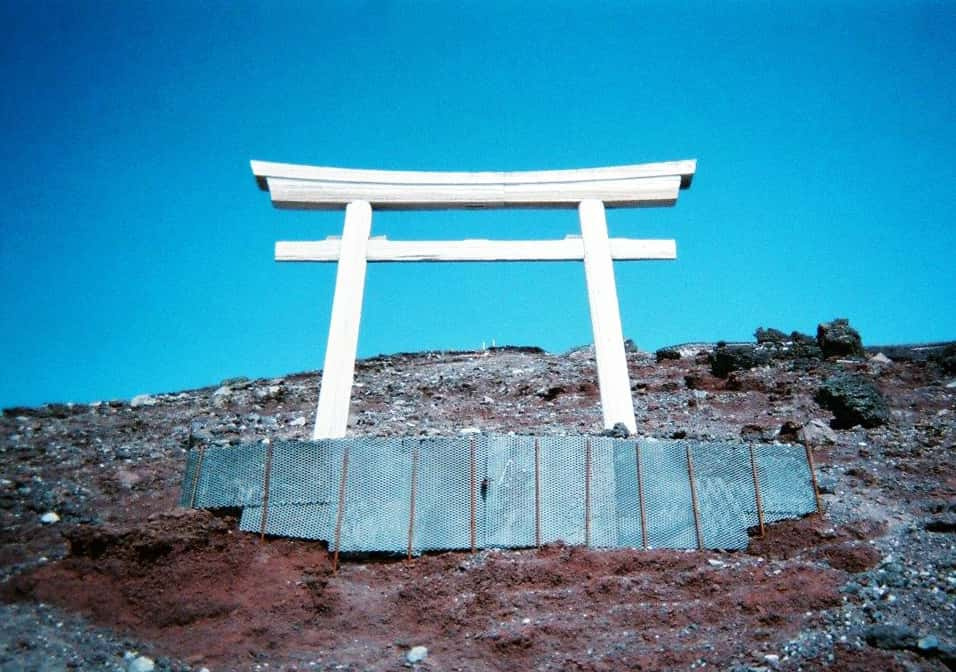
A large torii gate standing close to the 8th rest stopLooking from the mountain hut, on the left side there is a large torii gate standing beyond a rope. Since I was there, I climbed over the rope and up the jagged rocks to the torii gate, kneeled down, and prayed. Since the torii gate is a symbol of divine protection, praying at the sacred mountain and passing through the gate is also an important ritual. Still, the number of people was as sparse as ever. The weather was so beautiful that I thought that it was a shame that I was the only one to experience it. As time went on, the temperature continued to rise, and before I knew it, we were experiencing a hot summer’s day on the summit of Mt. Fuji.
However, something always happens when climbing a mountain. As I continued to walk up the steep slope, I gradually felt dazed I think because the oxygen was getting thinner. At first I thought this was normal since the altitude was getting higher, so I didn’t pay much attention to it and kept walking while still drinking plenty of water and trying to keep my breathing steady. After a while, however, not only did my head start to feel even fuzzier, but I also began to feel mildly nauseous. It was the same feeling I had when I ran my first marathon and became dehydrated and nauseous. I told myself that this was definitely not the way to go, and decided to take a break.
I had never experienced altitude sickness before, so I decided to take a break and I laid down in a corner of the trail for a while to see if my symptoms would abate. I had been walking at a fairly fast pace and had plenty of time to spare, so I took a 20-minute break under the shade in a rocky area. After that, I got up and started walking and I started feeling a little better. Still, once I started walking, the feeling of drowsiness gradually worsened, and at times I felt mildly nauseous, so once again I decided to take a longer break.
The second break was probably about 30 minutes. I had never taken such a long break during mountain climbing before. However, I was relieved to find that this break time seemed to help and I was able to walk without nausea from that point on.
Still Determined to Reach the Summit of Mt. Fuji!
Although the fuzziness did not disappear due to the effects of altitude sickness, I decided to continue climbing without any concern, thinking that everyone must experience something like this in order to reach the summit of Mt. Eventually, I reached the Mannenyuki Villa at the ninth station. Just one more breath and I would be at the top. The view from there was truly breathtaking. Looking back at the long trail I had hiked so far, I could see a sea of clouds spreading out ahead of us, and through the clouds I could see the plains below in the distance. The exhaustion of the long trail is healed just by looking at this view.
It was also concerning that there appeared to be zigzag tracks along the trail that looked as if a car had driven along the trail. The thought of “driving on this zigzag trail” flashed through my mind, as my previous mountaineering experiences had shown me that it was more enjoyable and time-saving to drive on zigzag mountain roads than to climb up and down steep slopes. Who could have imagined that this would force me to face the danger of getting lost on the way down the mountain?
The journey from the ninth station to the summit seemed so much longer than I had ever imagined. The oxygen was even thinner, and my mind felt somewhat fuzzy and I couldn’t think straight. To avoid further oxygen deprivation, I walked slowly and took things easy, and took deep and quick breaths to increase the concentration of oxygen in my lungs.
When I thought I finally made it to the summit, I found myself at the Chest Poke Hut at ninth and a half station. Just like its name, I felt my heart shatter. I didn’t even surpass 3590 meters above sea level, and there was still 186 meters of elevation gain to the summit. However, looking back, I could see the Pacific Ocean beyond the clouds to the southwest. Moreover, I could even see the Yaizu and Omaezaki coastlines in Shizuoka. One of my dreams had been to see the Pacific Ocean from Mt. Fuji. Once I got to this point, I had no other choice but to climb up with newfound vigor.
Conquering the summit of Mt. Fuji, where joy and pain coexist.
The clock turned 11:00 a.m. and it was finally time to conquer the summit of Mt. Fuji! This time I was finally getting to the real thing. The first thing I saw was a sign that said “Asama Summit Grand Shrine” and a torii gate. The excitement of having conquered the summit of Mt. Fuji was just overflowing inside me.
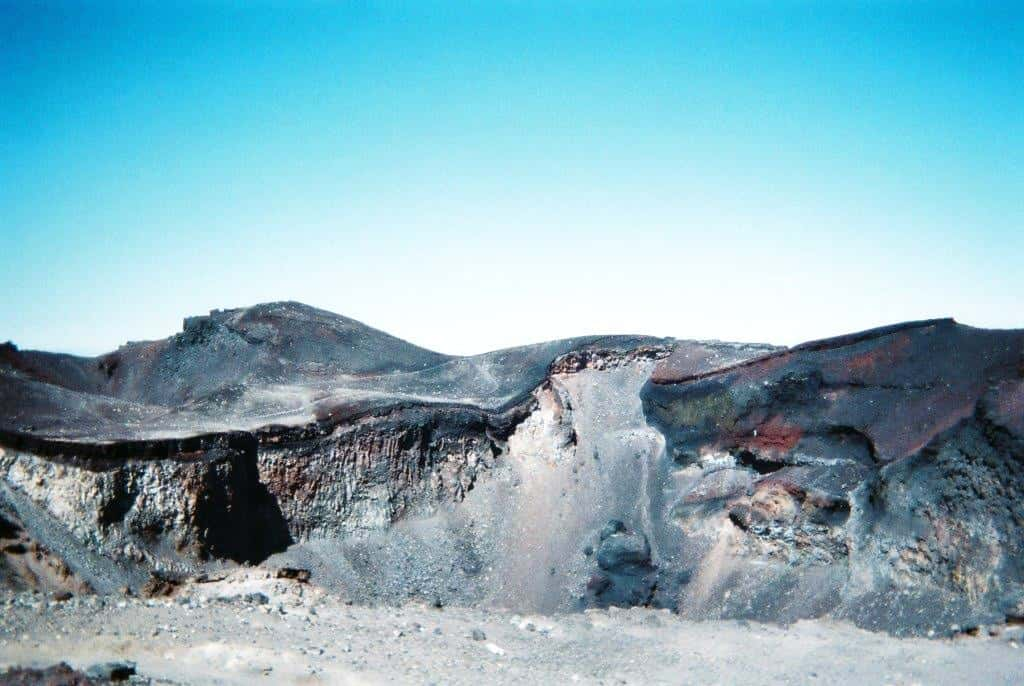
The brilliant colors of the volcanic crater on Fuji’s summit
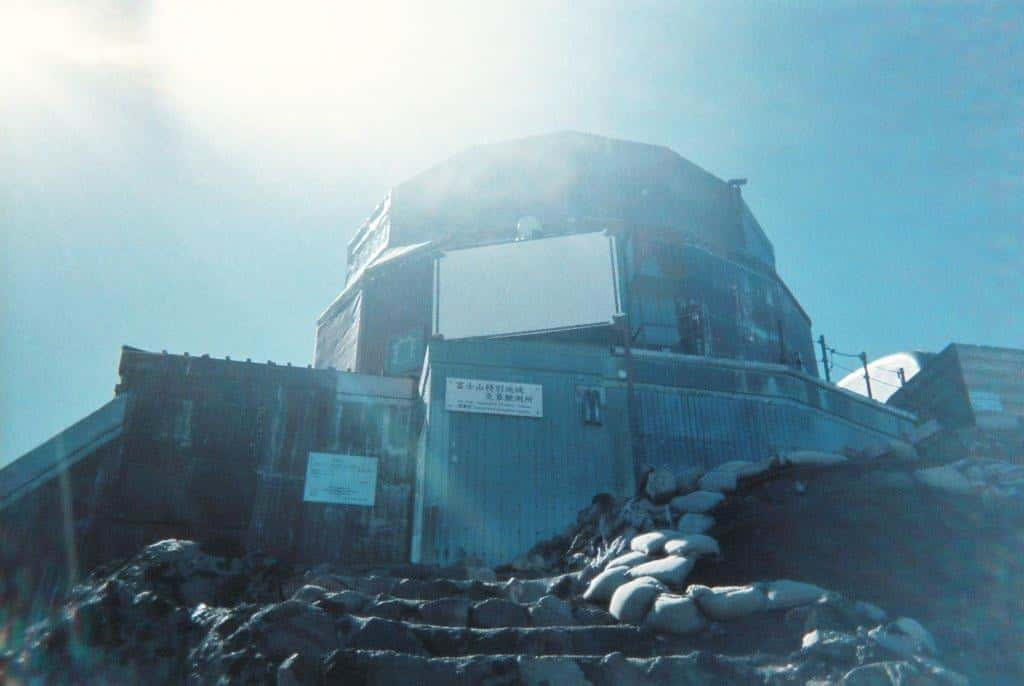
The Mt. Fuji weather station dome ruinsAfter a short walk later, we could see the volcanic opening of Mt. Fuji. The clear weather allowed me to see the beauty of the color and shape of the spectacular crater with my naked eyes, and suddenly I was filled with deep emotions. To the left of the crater, I could see the 3776-meter-high volcanic ring on the summit of Mt. Fuji.
Just then, I met a man who appeared to be in his 20s walking slowly while wearing running clothes. I thought it was amazing that a runner could run all the way to the summit, so I approached him and got a surprising answer. I asked him if he had made it to the summit, and he replied with a surprising answer: “I have a headache, so I don’t feel like running. It was clearly a symptom of altitude sickness, and I felt sorry for him. I asked him how he liked the summit, and he replied in a whisper, “My legs couldn’t take it anymore, so I turned around halfway up.
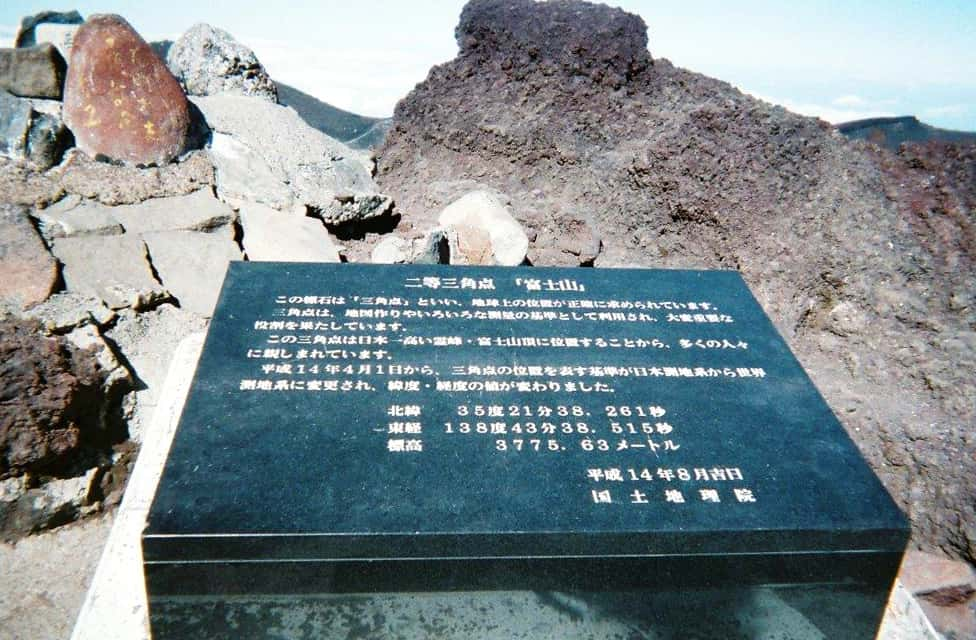
Mt. Fuji Second class of the triangulation point monument stoneIt seems that no one can really enjoy reaching the top of Mt. Fuji without experiencing altitude sickness. In fact, many climbers seem to suffer from altitude sickness, and the reality is that only a minority enjoy the summit in a truly healthy state. I had already known about the danger of altitude sickness myself, but fortunately, after overcoming the nausea, I felt extremely good except for a little lightheadedness.
From there, I climbed all the way up to Mt. Fuji’s Kenga-mine, just beyond the old Mt. Fuji weather station. In that brief moment, no one in Japan was closer to the heavens than I was. When I came to the very bottom of the dome ruins, there was a stone monument inscribed with the words, “Second class triangulation point Mt. Fuji. Here was proof that I was now at an altitude of 3775.63 meters. Beyond that, I saw the long-awaited stone monument that read “Japan’s highest peak on Mt. Fuji”. I felt all the emotions welling up. In both name and reality, I had finally conquered the highest peak in the Japanese archipelago, Mt. Fuji.
Mt. Fuji summit in calm conditions!
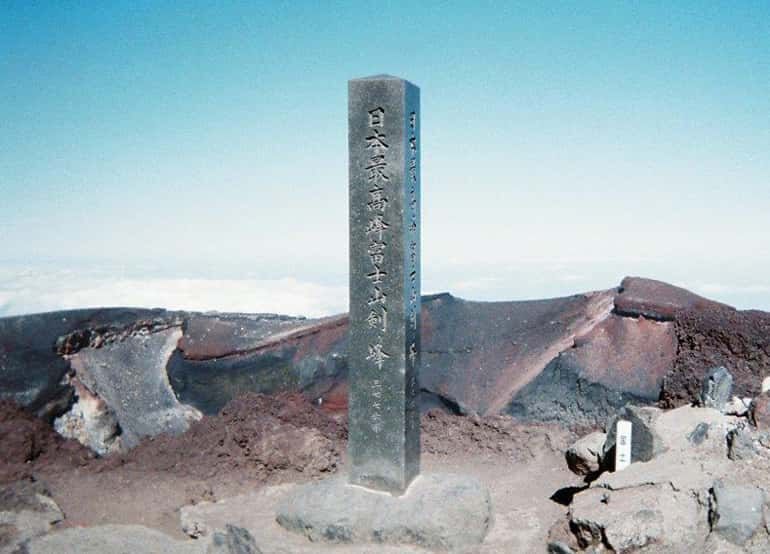
Kengamine, the highest mountain in JapanMt. Fuji, the highest peak in Japan, I was on cloud nine to have conquered the summit of Mt. Fuji in late September. The sun was shining brilliantly and the weather was a bit like a summer day. The ultraviolet rays were strong and my skin felt hot. Even so, the feeling of being bathed in the midsummer sun on the summit remained the same, as if I were in a dream or a fantasy. For a while, I was alone on the highest peak in Japan. Since I had come all this way, I decided to climb even higher, so I slipped through the chain of stairs at the observatory and climbed to an altitude even higher than 3776 m. The view from there was exquisite and words cannot do it justice.
During the off-season, very few people make it to the summit of Mt. Fuji. At one point on September 23, I suddenly felt a sense of superiority, knowing that no one else in the Japanese archipelago was closer to the heavens than I was.
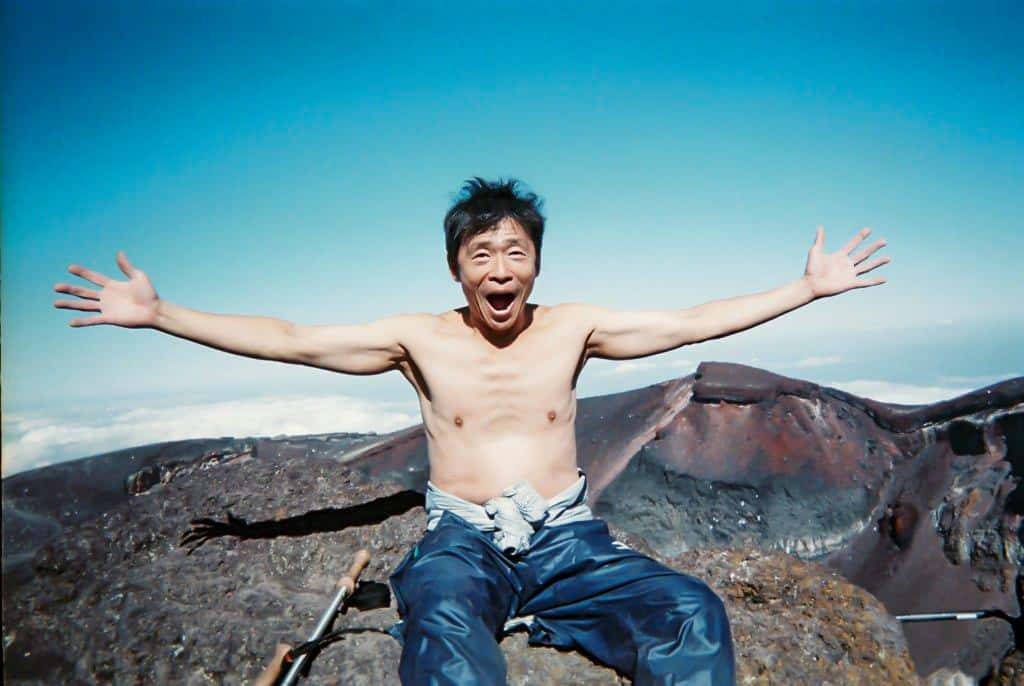
The warm off-season
at the summit of Mt. Fuji!Once I went back down the stairs, I met three foreigners who had climbed all the way up to Tsurugamine and I immediately spoke to them in English. They were a group of French people living in Germany. We took turns taking pictures for each other and I felt so hot that I ended up taking my shirt off to celebrate that I finally reached the top of Mt. Fuji.
Happenings are bound to occur at the summit of Mt. Fuji
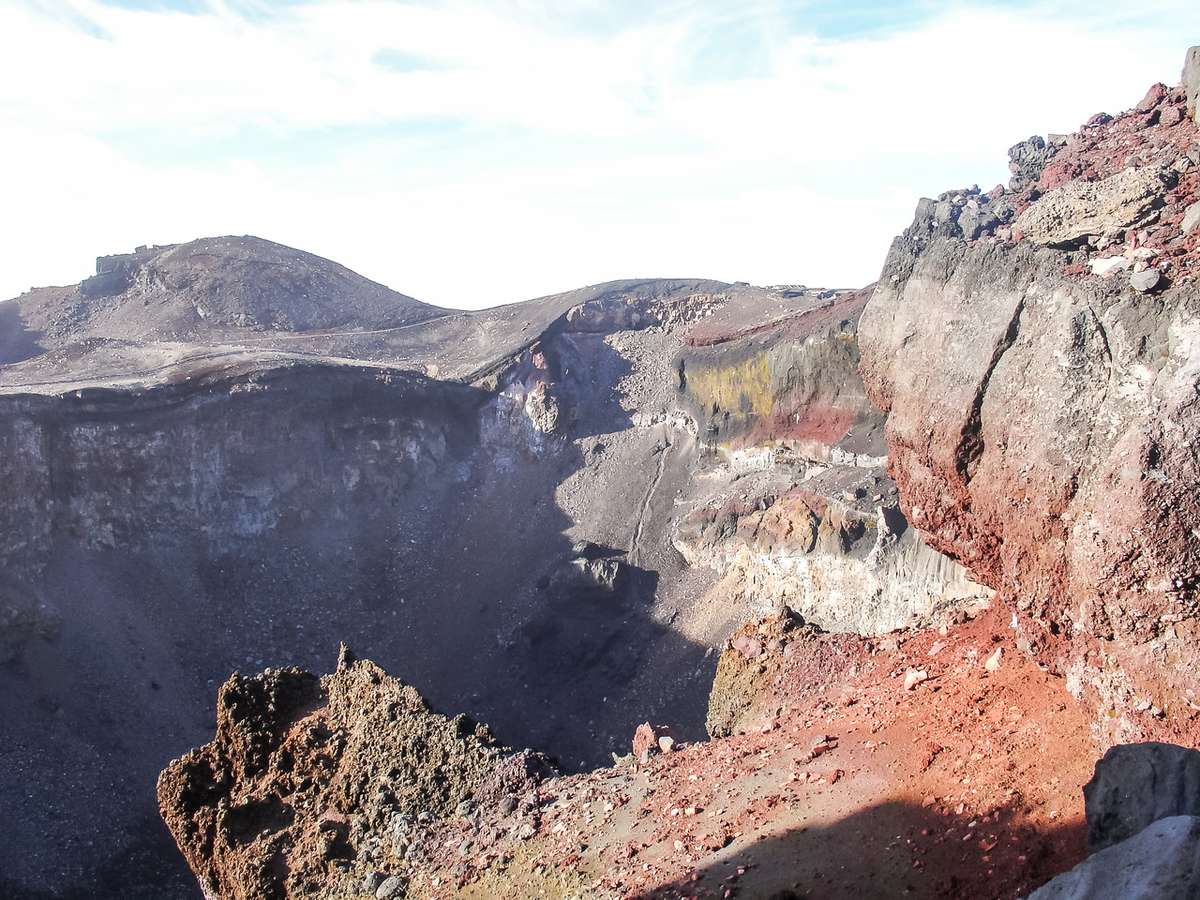
The Mt. Fuji summit craterWhile I was at the peak, I encountered an unexpected situation. As I pressed the shutter button of my camera to take a picture of the mountains in the distance, the 39-shot film camera I had purchased at a convenience store just ran out of film. What a shock on one of the best days of my life. There was only one thing left that I could do; I could ask the foreign climber I met at the summit to take some pictures and send them to me later. So, I asked one of the foreigners who became my friends to go up the observatory stairs with me, and we decided to take pictures of the view while talking about it together. Although this was unexpected of me to ask for this, I gave him my business card when we parted and asked him to please contact me.
At any rate, I was relieved to be able to take numerous photos of the views I saw from the summit and decided to circle the crater of Mt. Fuji. At that point, I was probably so engrossed with the scenery that I lost track of time. To begin with, I had no cell phone, no watch, and no way of knowing the exact time since I was only looking at the sun to get an approximate sense of time. I hadn’t even checked in advance how long it would take to go around the crater. However, it did not seem to take very long since I could see the entire crater in front of us. There was no wind at the top, and I was just so happy with the weather that nothing seemed too difficult.
The fear of altitude sickness makes you lose track of time!
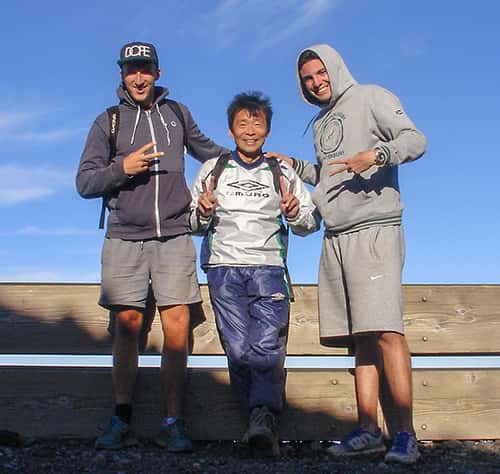
An Encounter with
some Germans at the summitThe time was probably around 2:00 PM. I looked around the summit and saw two foreigners in their 20s who were going around the summit crater, just like I was. They were both wearing shorts and surprisingly light summery clothing. But when I looked around, there was not a soul to be seen anywhere around the summit.
On September 23, these three climbers, including myself, were the last to descend from the summit of Mt. Fuji, so the three of us discussed the matter and decided to circle the crater together before descending. They were staying at a youth hotel in Shinjuku, and since there were no more shuttle buses going to the train station, I gave them a ride to the hotel. After about an hour of strolling around the summit, we got to know each other very well, and since I had forgotten my camera, I asked them to take many precious photos on my behalf.
Suddenly, I looked at the sun and noticed that it was almost 4:00 p.m., well past 3:00 p.m., given its position. Thinking about it, the sun sets around 6 p.m. and it would be dark by then, so I would have to finish my descent in about two hours. I started my descent immediately.
Descending the terrifying zigzagging roadway from the summit of Mt. Fuji!
Looking back, I don’t know why I left the trail and started running on the roadway; a little while after the three of us started our descent from the summit together, I saw the road by the side of the mountain trail. Based on my previous experience, it was faster to run on the road than to walk down the trail, so without thinking, I decided to split up and went on the road.
Perhaps it was because it seemed like this zigzagging road was an extension of the road I had walked on for a bit at the beginning when I started climbing the mountain from the fifth station. I didn’t think too much about it, and as if I was sucked in, I found myself just starting down that path. Certainly my judgment must have been clouded by the fact that I was dazed all the way at the top. I had no way of knowing that the zigzagging roadway was only for caterpillar trucks and not for people to walk on.
As soon as I started running, I realized that I could not control my body because the road was made of sand and rock that consisted of volcanic ash on a steep slope that I had never experienced before. The deep volcanic ash made for poor footholds and the slope was too steep, so once I got up to speed, I could not stop, and the only way to stop was to fall down. Another problem was the pain that comes with a fall. It would be fine if the ground was soft like sand, but there were rocks hidden under the volcanic ash that looked like sand, and every time I fell, I hit my feet and legs against the rocks, which hurt so much that I got bruises from it.
However, there was no way I could turn around and go back up the mountain trail from here, so I had no choice but to persevere and continue on, intending to walk as fast as we could. Even so, the foothold was so bad that I fell down many times, and it was a constant struggle. I told myself that this was ice hockey practice but when I tried to stop I kept falling down over and over again.
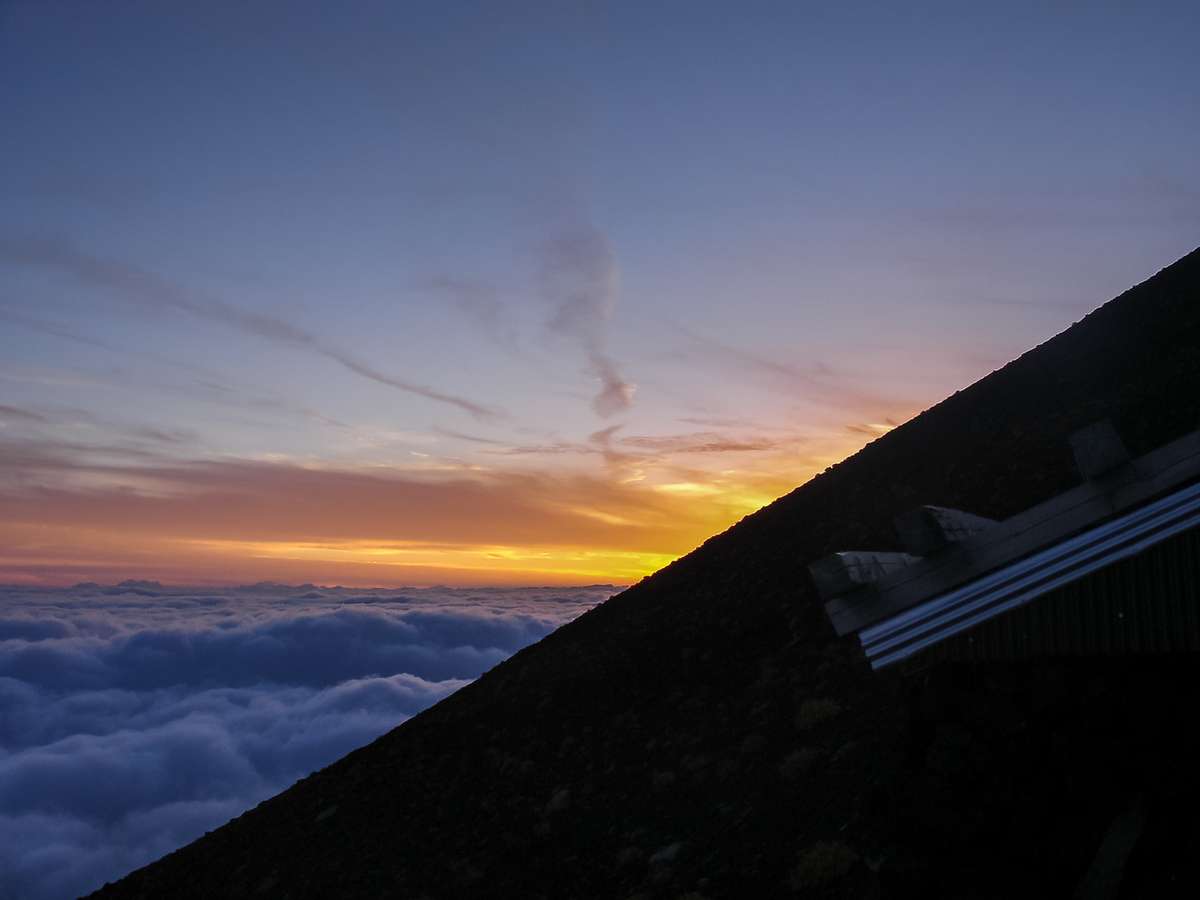
Dusk from the 7th station of Mt.Fuji
How much time did pass? Judging by the setting of the sun, it must have been close to six o’clock in the evening. My strength was beginning to dwindle, and just as I was getting tired of falling, I finally saw the mountain hut. I approached the hut, thinking it was probably around the seventh station, and to my surprise, there was a man climbing Mt. Fuji. He told me that he was going to sleep here today and go to the summit tomorrow. To my dismay, he told me that this was still the ninth and a half hut station. I could not believe my ears at all, as I had spent so much time struggling so hard to get down this mountain. It turned out that going downvia the zigzag path was hardly a descent at all and even that took a long time.
The crisis of losing a flashlight at night on Mt!
From there, I decided to go down the regular trail. By the time I returned to the eighth station, it was dark, probably because it was past sunset. Walking the trail at night was extremely dangerous, as the footing was poor and slippery even during the daylight hours. Also, since the weather was fine during the day, I hoped for moonlight, but the moon never rose and I could barely make out the faint lights of the city in the distance. So I decided to take out a manual flashlight and walk while turning the lever by hand. However, the bad terrain made it easy to lose my balance by moving my arms, which in turn made it easier for me to fall.
After about 20 minutes, I stumbled over a large rock and fell, dropping my flashlight. In doing so, the lever broke off, and in the pitch black darkness, I could not tell where it had gone. There was no way to find it because the rocky terrain was covered with volcanic ash. I was in big trouble. I lost my flashlight on the trail that night. I felt a sense of urgency growing as I realized that from this point on, I would have to descend the mountain using only my intuition and the faint light I could see in the distance. I was still between the seventh and eighth stations, and more hardship awaited me on the way down.
Surviving the darkness with only a safety tether
Normally I would have been able to descend to the fifth station in a little over an hour if it hadn’t been so dark. Still, I could not take it easy when I thought that my two friends from abroad who had descended the mountain earlier were waiting for me to return to Tokyo. After repeated trial and error, I came to one conclusion: I had to find a way to get back down to the fifth station. So, I decided to follow the ropes along the trail and fly without fear of falling down like the flying monkey man Sarutobisasuke.
Fortunately, I had two pairs of gloves with me, so I doubled up on gloves for each hand and began my descent. This was actually a very dangerous maneuver. Even though I had on ropes, the ground was bumpy and there were large rocks scattered in places, so it was inevitable that I would trip and fall. Also, if I went too fast, if I didn’t grab the rope as hard as I could, I would have been blown off our feet and gotten seriously injured. Moreover, we had to assume that our gloves would wear out.
Even so, I knew I had to get down the mountain as quickly as possible, so I kept walking, falling dozens of times, sometimes hitting my back and feet on rocks, but still persevering. Although I was able to adjust my walking speed by relying on the rope, there were many times when I still would lose my balance and end up dangling midair as if I was a tightrope walker in the circus. My gloves were beginning to wear out and my strength was nearing its limit, but I did not give up and continued down the mountain, hoping to somehow make it back to the fifth station. I told myself that life is about perseverance, and in the spirit of “falling seven times, getting up eight times,” I continued to descend the mountain even if I had to roll down the pitch-black Mt. Fuji to get to the bottom.
Thanks to an inspiring day of safe ascent to the summit!
Around eight o’clock in the evening, I saw a faint light in the distance. The light of hope came from the hut at the sixth station. I hastened toward the light with all my might and when I reached the hut I just melted down onto the bench.Then, two ladies from the hut came out and approached me. I told them what had happened and they told me that I could already reach the fifth station in a little more than 10 minutes. We paid 1,000 yen to purchase a flashlight from them, and I started my descent again. From there, the light from the flashlight illuminated the trail andI was able to descend the mountain with a sense of security, even though I only had my last bit of strength left.
I reached the fifth station rest house area at 8 o’clock. It was already pitch black and not a soul could be seen. According to the lady at the lodge, my fellow German friends had returned more than two hours earlier.They must have been picked up by someone else and were driven to a nearby hotel. As sad, frustrating, and pathetic as it was, I still feel like it was the best day of my life.
In fact, this was the most memorable trip of my life. I am so glad that was able to successfully complete an off-season climb on Mt. Fuji!

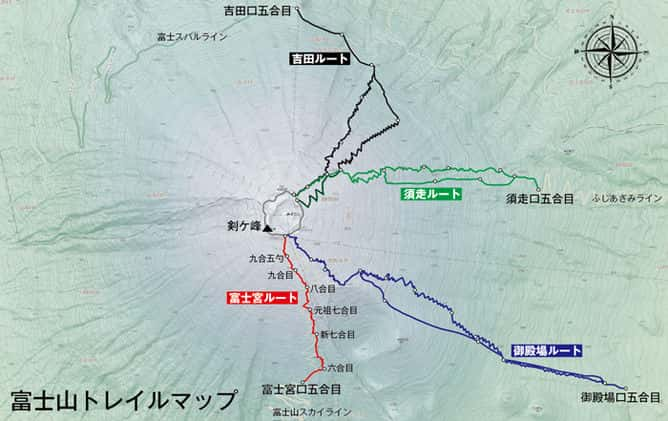
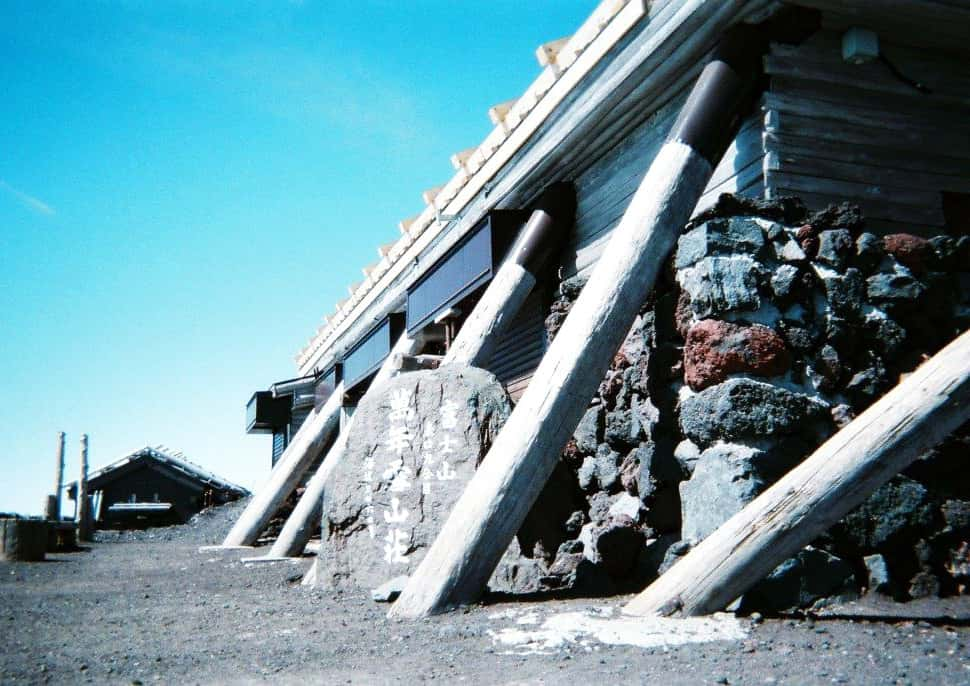 Mannenyukisanso at the 9th Station of Mt. Fuji
Mannenyukisanso at the 9th Station of Mt. Fuji